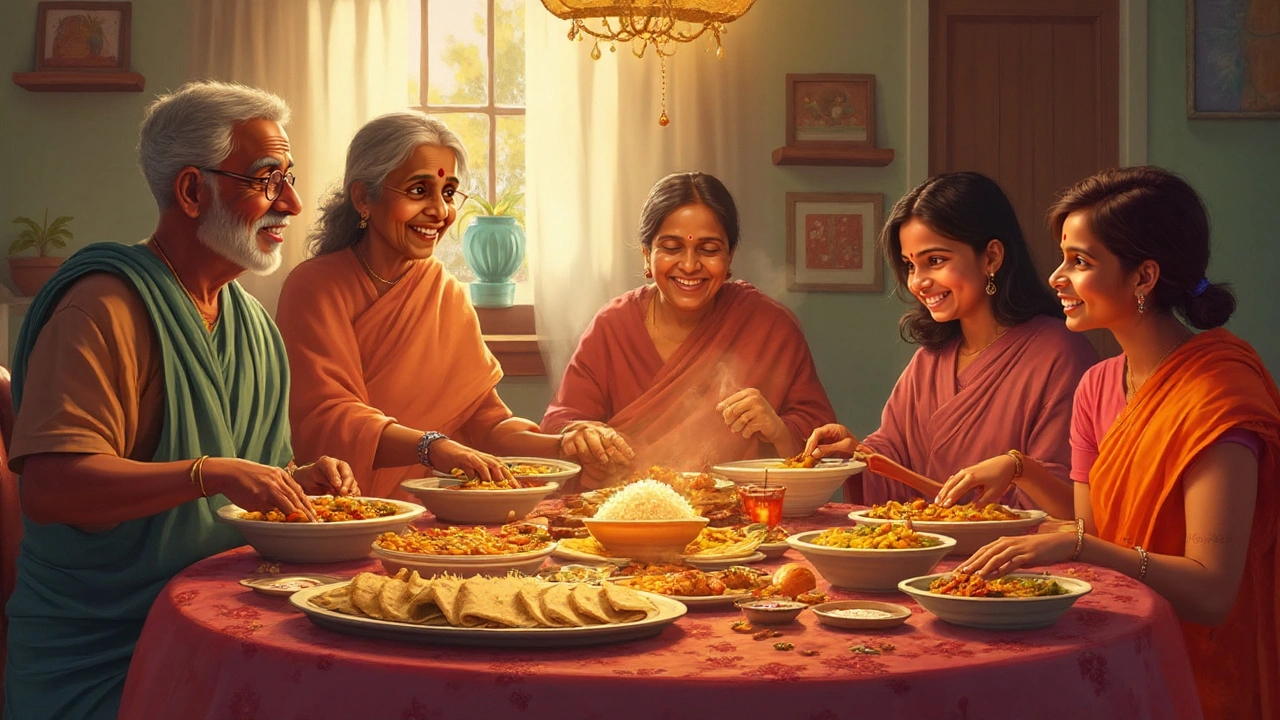Ever seen your curry turn into something closer to soup than the luscious, thick gravy you’d imagined? Yeah, nothing disrupts a dinner plan faster than a watery curry swimming on your plate. A thinner consistency can mess with the flavors, ruining that comforting spoonful you expect with your rice or bread. If you’re tired of praying over a simmering pot, hoping for magic to somehow make your curry thicker, it’s time to actually take charge. No complicated chef tricks or mystery powders here—just reliable ways to get perfectly thick curry right in your home kitchen. Let’s roll up those sleeves and fix that sauce for good.
Science of Curry Consistency: Why Cooks Struggle (and Succeed!)
The big secret? Curry thickness comes down to a balancing act between water, fat, and the tiny starches in your ingredients. Different parts of India crave their curries different ways: North Indian gravies like paneer butter masala or butter chicken are famously creamy and bold, designed to hug every bit of naan. Go south or west, and you’ll find lighter coconut-based sauces or thinner dal broths. But everyone agrees: unless it’s meant to be rasam, nobody wants curry soup unless soup is the point!
Let’s talk why you might lose that dreamy texture. Using too much water or stock, not enough base vegetables, cooking at a low heat, or skipping the sauteé step can dilute the dish. Sometimes you’ve just followed a recipe that wasn’t made for your juicy tomatoes or that scary, watery shop-bought coconut milk. There’s a little science behind what turns a curry thick: starches from onions, legumes, or potatoes absorb water as they cook, fat from ghee or cream acts as a binder, and reducing liquid through simmering lets all these do their job.
Fun fact: a 2021 study from the Indian Institute of Food Processing Technology found that curries thickened with blended lentils (like dal makhani) had a 60% higher perceived "mouthfeel" satisfaction rating than those with added flour or starch. People notice the difference—it’s not just aesthetics! There’s evidence, too, that thick gravies can make spices taste richer because they linger longer on your palate. Clever cooks play with this: North Indian families often use browned onion-cashew pastes, while home cooks in Kerala might throw in mashed yam or taro. Modern kitchens even use chia seeds or xanthan gum to keep things gluten-free.
So if your curry is lacking body, you’ve got options. The best choice depends on the ingredients (is it tomato-based? loaded with cream? vegan or meaty?) and how much rescue work you need. Each method has its quirks, but once you know why your curry is thin, you can fix it with confidence. Next, let’s run through the easiest (and tastiest!) ways to recover from runny curry disaster.

Fixing a Watery Curry: Classic and Unexpected Fixes for the Home Cook
Staring at a pot of watery curry? Don’t panic—there’s almost always a fix. Let’s break down your go-to thickening tricks, plus a few clever upgrades you probably haven’t tried.
- Simmer It Down: This one sometimes sounds like cheating, but it’s the first thing pro chefs do. Just turn up the heat to a medium simmer and don’t cover the pan. Let liquid gently bubble off, stirring now and then. The sauce shrinks and the flavors get more concentrated. You might be surprised how much thickness you get in 10-15 minutes. In my kitchen, rescuing chicken tikka masala this way got nods from even picky eaters.
- Blend Your Base: The magical glue in curries often comes from onions, tomatoes, nuts, or cooked lentils. If you sautéed onions or garlic until soft, blitz them with a bit of your sauce and pour it back in. This trick gives a velvety finish and works especially well for tomato-based gravies. Pro tip: some North Indian restaurants use fried onion paste to get that almost fudgy texture in their curries.
- Add Starch: If you need a speedy fix, there’s no shame in grabbing your trusty cornflour (cornstarch). Mix about a teaspoon with cold water, whisk into a smooth paste, then stir into your hot curry. Let it bubble for a couple of minutes so it cooks through. Potato starch, arrowroot, or rice flour can do the job, too. Some cooks pinch in a little besan (chickpea flour) for an even more authentic flavor—just roast it in a dry pan for a minute first so it doesn’t taste raw.
- Use Purees or Mashed Veggies: Spoon in mashed potatoes, pumpkin puree, or cooked lentils for instant thickening. My spouse Arjun swears by cooked red lentils—they disappear into the sauce, sneaky but effective. Bonus: this method is both gluten-free and protein-boosting. I once saved a soupy korma by blitzing a cup of cooked chickpeas straight into the sauce. No one complained.
- Cream, Yogurt, and Nuts: Cream, coconut milk, or plain yogurt thicken curries and add richness. To avoid curdling, always stir in yogurt slowly with the heat turned way down. Slivered cashew or almond paste packs a triple punch: creamy texture, flavor, and gorgeous sheen. If you want a Mughlai touch, blitz soaked nuts with a splash of milk to make a thick paste, then simmer in gently.
- Gram Flour & Roasted Flours: Toasted besan or wheat flour acts as a secret weapon. Just add a spoon of flour to a dry pan, stir until it’s fragrant, and whisk into your sauce for thickness with minimal fuss. Great for vegan curries without nuts or cream.
- Instant Gratification: Ready Thickeners: Rice flour, ground oats, or even a few crumbled rice cakes work for a pinch. Some folks toss in cooked and mashed rice. I’ve even seen cooks sneak in a tablespoon of instant mashed potato when no one was looking. Necessity is the mother of invention, right?
- Tamarind, Jaggery and Balance: Not exactly thickeners, but adding tamarind pulp or a bit of jaggery masks any "starchiness" and boosts flavor if your fix has dulled things down a bit.
Here’s a helpful comparison of the thickening power of common household ingredients, based on hands-on kitchen tests (per 1 tablespoon added to 2 cups of curry):
| Thickener | Estimated Thickness Change | Flavor Impact | Gluten-Free? | Best For |
|---|---|---|---|---|
| Fried Onion Paste | High | Savory, deep | Yes | North Indian, Mughlai |
| Cooked Lentil Puree | High | Smooth, earthy | Yes | Vegan, protein-rich |
| Cornstarch Slurry | Medium | Mostly neutral | Yes | Quick fix, Asian curries |
| Ground Cashew/Almond Paste | Moderate | Nutty, rich | Yes | Festive, creamy gravies |
| Roasted Gram Flour (Besan) | Medium | Nutty, toasty | Yes | Chickpea-heavy curries |
| Coconut Cream | Mild | Tropical, creamy | Yes | South Indian, Thai |
| Mashed Potato | Medium-High | Mild | Yes | Quick fixes, vegan |
Keep in mind that some combos work better than others. Adding a thickener with a strong flavor (like mashed lentils) to a delicate coconut curry might overwhelm it. Match the fix to the dish! If in doubt, test with a tablespoon in a little bowl before dumping in the whole lot.

Pro Tips, Kitchen Myths, and Real-World Hacks for Thicker Curry
Seasoned cooks have a few extra tricks up their sleeves. If you’re after top-tier home cooking, the little details matter as much as your thickening method. We’ve all heard the advice—some genius, some odd. Ready for some real talk about what truly works?
- Browning Wins: Starting your curry by browning onions, garlic, or ginger until they caramelize works wonders. The sugars break down, add natural sweetness, and create a richer base to trap all those flavors—and it’s a smart, easy way to get a thicker, silkier sauce.
- Don’t Skip the Sautee: If you throw everything in and boil from the start, you’ll miss that secret extra body. That early, sizzling stage (even if it adds ten minutes) turns onions and spices into the backbone of a dense, solid curry.
- Cool Down Before Adding Dairy: If you use yogurt or cream, give your curry a couple minutes off the heat before adding. Sudden heat splits dairy, making your curry watery and grainy. I learned this the hard way with a gorgeous spinach curry, and now I never rush that last step. My mother-in-law always stirs in yogurt with the pan half off the flame—she’s never had a sauce break on her watch!
- Bigger Isn’t Better: Resist the urge to use giant pans or massive pots unless you’re feeding a crowd. More surface area means faster evaporation, which can help thicken but also means flavors can get too concentrated or uneven.
- Chill for an Hour: Lots of curries thicken beautifully as they cool. If you’re meal prepping, let the flavors rest, then reheat gently. You’ll be surprised how much silkier your gravy gets in the fridge.
- Layer, Don’t Dump: Instead of adding all your thickener at once, incorporate slowly—a little at a time, each time letting the curry simmer for a minute before tasting and adjusting. Saves you from ending up with curry glue instead of curry glory.
- Fake It with a Pulse: If all else fails, give your curry a quick once-over with an immersion blender. You can even scoop out a cup, blitz it, and pour back in—no one will guess you took a shortcut.
- Common Mistakes: Don’t thicken curry with wheat flour unless you’re making a very European-style dish. The flavor and mouthfeel can turn gummy fast. Likewise, avoid adding raw flour straight to hot liquid, or you’ll get lumps and a raw flour aftertaste.
- Not All Flours Are Equal: Rice flour is your friend in gluten-free Indian and Asian gravies; wheat flour not so much. Potato starch adds smoothness—especially handy for creamy coconut curries.
Here’s one more thing—no two curries act exactly the same, even if you follow the recipe three times. The tomato you use, how much water your onions hold, even the altitude of your kitchen—they all matter. I live in Sydney, where humidity swings can play tricks on an otherwise bulletproof buttery dal. That’s why seasoned cooks always taste, adjust, and learn to trust their senses. Experience beats following recipes to the letter.
So the next time someone in your house grumbles about a watery curry, give them a wink, toss in that secret fried onion paste, or slip in a scoop of cooked lentils, and watch their eyes light up when they dig in. Fixing a curry isn’t a sign you messed up—it’s proof you know how to deliver on flavor, texture, and the kitchen confidence that turns every meal into something memorable.
